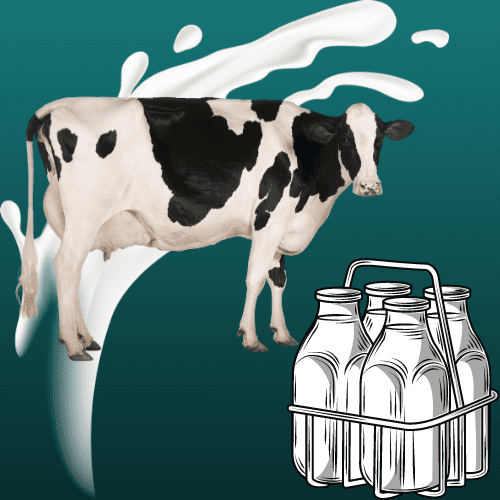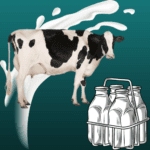
Last week we covered how milk transformed from a drink mainly found on a farm to a staple in every American home. Once pasteurization and homogenization were widely used, the industrial mass-production of milk created a surplus of milk that was before unimaginable.
Some of this milk could be used for chocolate, ice cream, yogurts, and cheeses but for the most part, it became necessary for the dairy industry to sell mass quantities of milk, fast. As World War II loomed, American industry was looking for a way to use all the milk it had on hand. Milk is a nutrient-dense, high protein, high-fat, high sugar substance, and so “strength” became a focus. Condensed milk became a staple for troops, but there was still a need to sell fluid milk.
In 1940 Chicago rolled out the first Subsidized Milk Program in low-income schools providing free milk for those who could not pay. Shortly after, advertising for Federal Milk Programs became a WPA New Deal project. The goal of the project was to give work to artists and writers and create a demand for milk to offset the milk surplus.
During wartime, it became the American’s patriotic duty to make sure their children were getting daily milk. The USDA put forth that milk was, “a weapon against the most dangerous enemy of democracy – malnutrition.” It also stated children without milk, “are not able to enjoy the full advantage of education provided at community expense. They are not fully armed for citizenship.”
Dairy producers were asked to provide more condensed milk and cheese for military support; however, farmers couldn’t afford to produce on these levels without selling higher quantities of fluid milk which made more money. In 1946 Truman passed the Federal School Lunch program where it was mandated each school lunch included between half to two pints of whole milk. Today, it is illegal for schools to restrict or impede the sale of milk. The USDA’s “More Milk for More Children” campaign locked in the consumer base needed for fluid milk.
The 1950s was the golden era of food advertising, and milk was the most promoted item. Single-use milk crates waxed with DuPont’s polyethylene plastic replaced glass bottles and marketed as a more sanitary, modern, alternative. Considering milkmen frequently poured half-used bottles together to make new bottles of milk, the switch likely was more hygienic. The USDA placed milk as its own food group in its nutrition charts. The milkman disappeared as homes acquired refrigerators and suburban sprawl made routes too long.
Alta Dena’s website dedicates only a couple sentences about it’s history – emphasizing its dedication to traditional quality. However, the full Alta Dena story involves fifty years of lawsuits. By the 1950s California had become the nation’s biggest dairy producer and Alta Dena was one of the largest California dairies.
Alta Dena was founded by Herold Stueve and two of his brothers. Herold Steve’s obituary in the LA Times describes, “Stueve spoke softly and had the plain and honest features of a farmer, which camouflaged an intense side that helped him wrangle with officials.”
What made Alta Dena controversial was its dedication to providing raw milk alongside its pasteurized milk options. While most states had banned raw milk, California was one of the only states that never implemented a full ban on the sale of raw milk. Herold Stueve believed pasteurization stripped milk of its essential enzymes and broke down beneficial proteins. From the 1950s through the 1990s Alta Dena was continuously bombarded with lawsuits.
One lawsuit in 1989 held Alta Dena responsible for a Listeria outbreak that killed 10 newborns and 18 adults. The Listeria outbreak was traced to a cheesemaker that Alta Dena had sold to, which didn’t have the finances to pay the victims. Alta Dena kept cows in pens, instead of pasture creating which made a fair case. Conversely, Alta Dena had also sold the same batch to 30 other buyers, none of which were traced to contamination. Raw milk advocates point to many of these lawsuits being unfounded litigation at the hands of Big Milk and the USDA to force consumers no other option than processed milk.
The decades of Alta Dena litigation stigmatized and polarized the public’s view of raw milk. It helped support public logic that milk was essential, but it has to be ultra-processed to consume. Eventually, Alta Dena couldn’t survive being the only major provider of unpasteurized milk even if it was legal in California. Today Alta Dena is a conventional dairy producer.
Through the 1970s and 1980s, the public was very willing to accept that more processing was healthier. In 1980 the USDA advised that milk should be consumed in moderation, which felt like a stab in the back to Big Milk. Big Milk assumed the USDA was there to promote them instead of set dietary health codes for the public. To meet the demands of a consumer market that was turning to margarine as a healthy alternative to butter, Big Milk created skimmed, low-fat, and 2% milk which became normal. These extra-processed alternatives remove most of the nutritional value of milk and add in synthetic forms of vitamin D and sugar; but it made the public feel safe in avoiding fats.
In 1990 a Milk Research and Promotion Board was created and overseen by the USDA. It takes a fraction of milk profits to generate about $400 million for the agency annually. This is the funding that created the Got Milk campaign, which emphasized strong bones for children instead strength to fight a war. Despite the fact Got Milk is one of the largest and most successful marketing campaigns ever, today shoppers drink half the milk they did in 1975. People have discovered milk is difficult to digest and the rise of plant-based milks has ousted Big Milk.
In recent decades, yogurt and cheese sales have increased by 200%. The Research and Promotion Board works with brands like Taco Bell to use ten times the cheese that would be in a taco for its “grilled cheese burrito”. It partners with Domino’s for school lunch programs to add cheese.
Today, the Milk Research and Promotion Board is still turning out advertising that makes fun of plant-based milks, like the Aubrey Plaza one below. The USDA can simultaneously advise against drinking too much milk and help Big Milk with these marketing campaigns. The USDA doesn’t create milk marketing today but only oversees it so that today everyone can have their milk and drink it too. Next week we will look at lactose intolerance.

